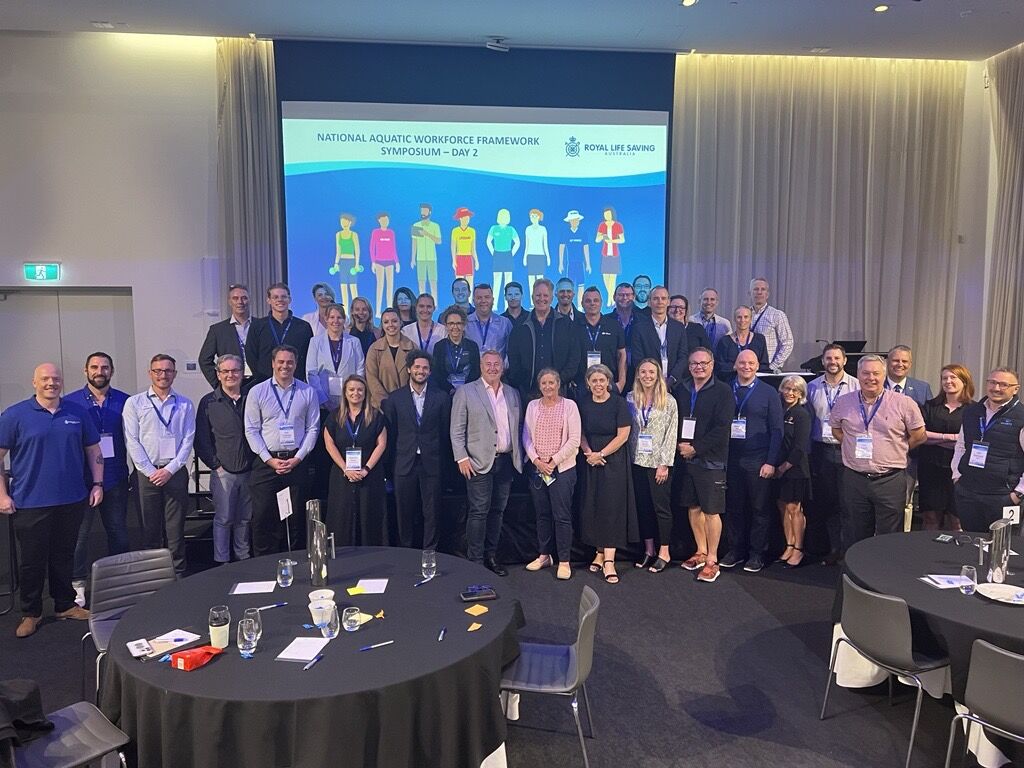Published: 18 March 2024
Aquatic Industry leaders convene to strengthen workforce development and career pathways, for a sector that plays a critical role in community safety, health and well-being.

12-13 March 2024, Melbourne, Australia – the National Aquatic Workforce Symposium, convened by Royal Life Saving Australia and the National Aquatic Industry Committee, brought together 50 industry leaders with a unified commitment to enhancing community safety, and ensuring a sustainable and capable workforce for Australia’s more than two thousand aquatic facilities.
The aquatic industry employs over 65,000 workers, provides safe places to swim and learn swimming and water safety skills and delivers $9.1 billion annually in health, social and economic benefits.
The Symposium's purpose was to craft a National Aquatic Workforce Framework aiming to promote the attractiveness of a career in aquatics, clarify career pathways, reinforce the role of ongoing learning and development.
Presentations, panel discussions and workshop activities focused on career pathways for key roles from pool lifeguards, swimming and water safety teachers, customer service officers, duty managers through to facility and senior managers.
RJ Houston General Manager – Capability & Industry at Royal Life Saving Society - Australia, said industry leaders convened with a strong sense of purpose and shared commitment.
“The Symposium was a critical step in bringing together key stakeholders to collaboratively address the challenges and opportunities facing Industry, and to develop a National Aquatic Workforce Framework. We were all struck by the expertise in the room, and by just how many people had developed a passion for aquatic safety, forged careers and built leadership skills from early experiences in jobs like lifeguards and swimming teachers."
Georgie Nichol, General Manager - AUSTSWIM, emphasised the role of collaboration.
“The Symposium highlighted the industry wide, collective leadership intentions to explore a workforce framework that will strengthen the richness of our aquatics community as a whole. Scaffolding development, attracting and retaining diverse talent and building systematic pathways for opportunities and growth were all critical elements discussed to enable and support meaningful and lasting careers in aquatics."
Ben Tudhope, General Manager - Partnerships at Aligned Leisure, highlighted the importance of a sustainable workforce.
“Our goal is to foster a supportive environment where aquatic professionals can thrive, ensuring the long-term sustainability of our industry and the safety of those we serve."
Tim Goward, Manager - Major Venues at City of Gold Coast, underscored the importance of focusing on community outcomes brought about by the aquatic workforce across the various groups and interests that collectively make up the aquatic industry.
“This Symposium has been instrumental in forging national-level alignment and collaboration among various stakeholders. It's a testament to a collective dedication to not just the industry but the broader community’s wellbeing."
The Symposium laid the groundwork for a robust framework, promising to strengthen a workforce dedicated to the well-being and safety of communities across Australia.
For further details on the National Aquatic Workforce Symposium and the National Aquatic Workforce Framework, please visit https://www.royallifesaving.com.au/Aquatic-Risk-and-Guidelines/Engagement-Events-and-Forums/national-aquatic-workforce-symposium
About Royal Life Saving Society - Australia
Royal Life Saving - Australia leads collaborative and systemic approaches to drowning prevention and water safety, and has a deep commitment to collaboration, evidence-gathering, research, advocacy, policy development, health promotion, education, training and workforce development and lifesaving development. For more than 130 years, Royal Life Saving has sought to reduce drowning, increase physical activity, especially in and around the water, and to contribute to the creation of more resilient communities, Australia-wide.
